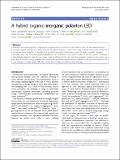A hybrid organic-inorganic polariton LED
Abstract
Polaritons are quasi-particles composed of a superposition of excitons and photons that can be created within a strongly coupled optical microcavity. Here, we describe a structure in which a strongly coupled microcavity containing an organic semiconductor is coupled to a second microcavity containing a series of weakly coupled inorganic quantum wells. We show that optical hybridisation occurs between the optical modes of the two cavities, creating a delocalised polaritonic state. By electrically injecting electron–hole pairs into the inorganic quantum-well system, we are able to transfer energy between the cavities and populate organic-exciton polaritons. Our approach represents a new strategy to create highly efficient devices for emerging ‘polaritonic’ technologies.
Citation
Jayaprakash , R , Georgiou , K , Coulthard , H , Askitopoulos , A , Rajendran , S K , Coles , D , Musser , A , Clark , J , Samuel , I D W , Turnbull , G A , Lagoudakis , P & Lidzey , D 2019 , ' A hybrid organic-inorganic polariton LED ' , Light: Science & Applications , vol. 8 , 81 . https://doi.org/10.1038/s41377-019-0180-8
Publication
Light: Science & Applications
Status
Peer reviewed
ISSN
2047-7538Type
Journal article
Description
Funding: Authors thank the U.K. EPSRC for funding this work via the Programme Grant ‘Hybrid Polaritonics’ (EP/M025330/1) and for funding Ph.D. scholarships for K.G. and H.C. through a DTG allocation.Collections
Items in the St Andrews Research Repository are protected by copyright, with all rights reserved, unless otherwise indicated.

